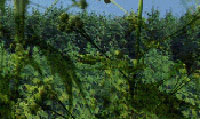
VIRGINIA SIDA is the solution ...
Virginia sida (Sida hermaphrodita L. Rusby) belongs to the Mallow family (Malvaceae) and it originates from the USA. As a result of more than 55 years of research conducted by Lublin University of Sciences, sida is now recognized as one of the most important cultivated plants. This is due to the wide range of possible applications, including usage for energetic purposes.
This wonderful plant provides great opportunities for bee-keepers as well. It's a real bee pasture. Sida is a highly valuable cultivated species high in protein. The plant provides high honey yield, but it is also very good for energetic applications. The plant can be cultivated in cohesive soil and even on sandy soil as well. Cultivation is really economical even on lands with a value of 12-14 AK ("Gold Crown", Hungarian unit) and it's really useful for several different purposes. After the third year following planting, the species grows 20-40 stems from one stool which stems will die back during winter. For energetic purposes, the best solution is a plantation with 30-120 thousand stools/ha. The plantation will live for 20-30 years. Virginia sida will provide a good harvest on all kinds of lands, even on dry, cohesive or sandy lands having a value of only 10-something AK.
Virginia sida completely resists frost and drought. In the first period, it grows quite slowly and it's very sensitive to weed; especially in case of plantation created by way of open ground sowing, that is why preparation of the soil and proper agrotechnics are so important. Weed simply grows faster and holds back the young shoots. In its first year it reaches a height of 60-90 cm, very slowly, but from the second year it grows to 2.5 - 4 meters.
The amount of harvestable Virginia sida depends on many factors. Depending on the quality of the arable, 9-25 tons dry weight/ha/year can be harvested, but for example an arable with medium quality will result in 20 tons dry weight/ha/year from the second year.
Virginia sida has a really beneficial cultural feature. It can live on lands contaminated by hydrocarbons or heavy metals, even on sewage sludge. Moreover, it "cleans" the soil during its cycle of vegetation, practically making recultivation possible.
Virginia sida doesn't require special artificial fertilizers. Depending on actual usage, addition of 100-170 kg of nitrate fertilizer per ha is recommended. read on...

